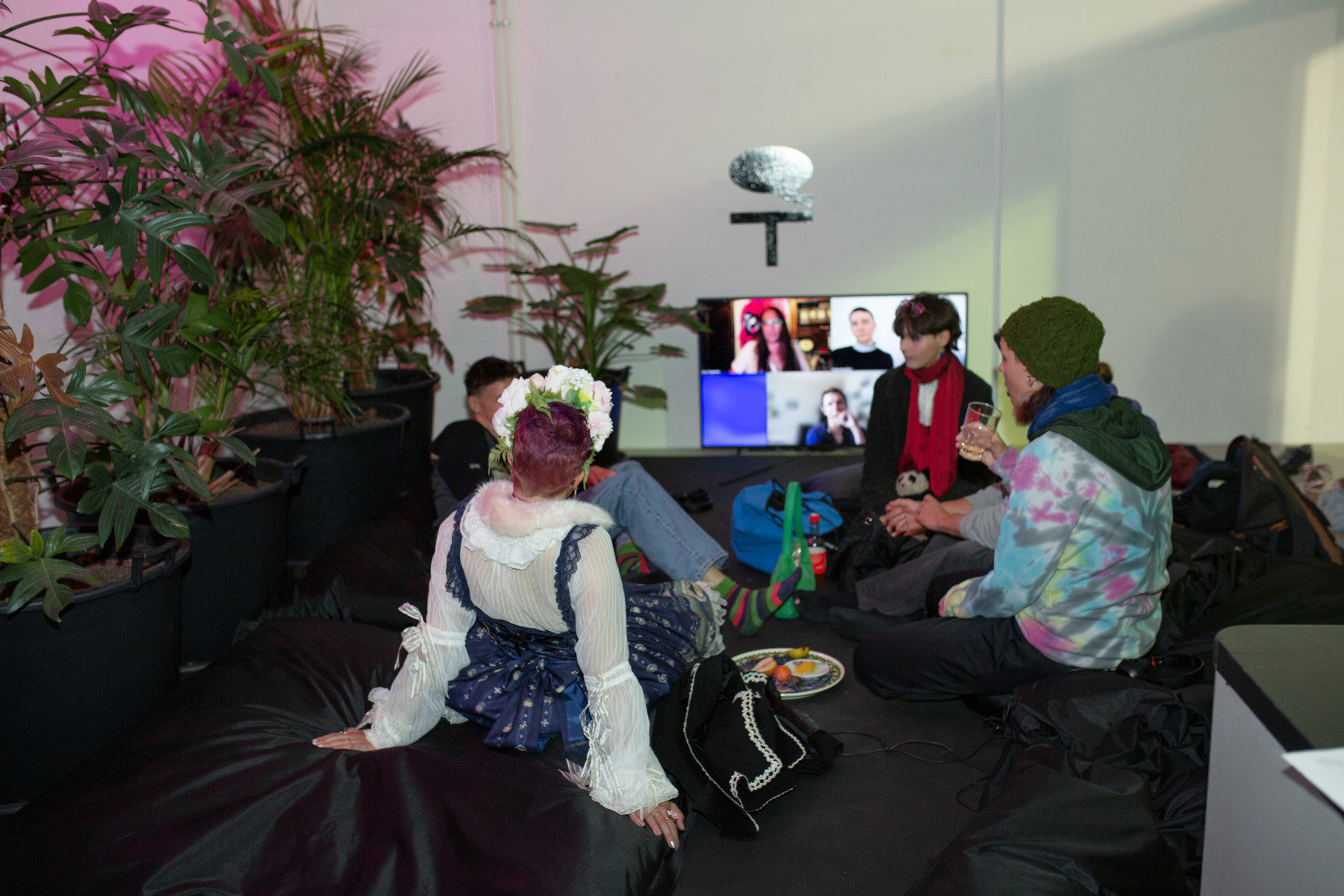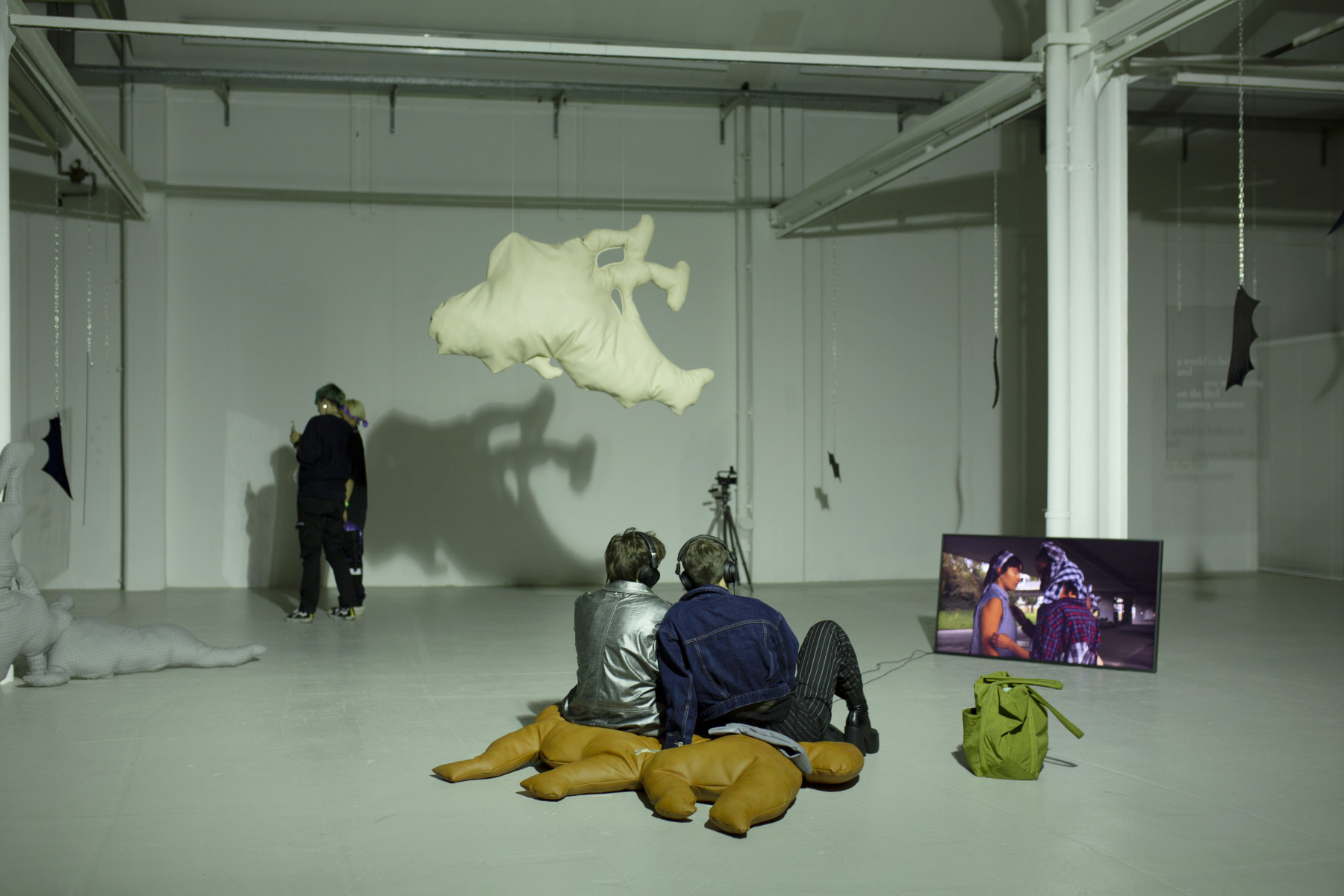Protozone 8: Queer Trust
Shedhalle Zürich
by Theresa Roessler

Dorota Gawęda & Eglė Kulbokaitė, Leave No Trace (Athens) I-VIII, 2022; in the front: Freestanding Votive Flowers (I–VI), 2022. Shedhalle Zurich 2022, Protozone8 - Queer Trust, photo: Carla Schleiffer, Courtesy of the artists.
“Trust is temporary and unstable. It’s a belief. It’s about taking a risk”. So states cultural worker Laurence Rassel in a recorded discussion with the artistic directors of Shedhalle Zurich, Thea Reifler and Phila Bergmann, together with musician Terre Thaemlitz. Already within this, we see addressed a connection essential to the current exhibition Protozone 8: Queer Trust, i.e. the connection of trust that emerges between the parameters of temporality, credibility, integrity and intention. The one-hour-long conversation, shown in somewhat of an antechamber preceding the exhibition space, not only welcomes the visitors but functions as a prologue that offers an uncommonly honest insight. Thea Reifler and Phila Bergmann reflect on their own experiences, respectively, of how fragile relationships of trust between curators and artists can be, and of the factors on which this depends. Considering the art institution as embedded within a highly hierarchical system, an invitation goes hand in hand with relationships of power and dependency, which sometimes tend to reduce trust rather than strengthen it. Above all, the two are aware of a contradictoriness inherent to the exhibition’s title, which is capable of opening up new processes, yet, as a kind of "label", it can be reductive or even impedes a process. These interpersonal relationships, the processes of negotiation or the actual making of the show remain invisible, but the video conversation reintroduces these themes into the exhibition space and adds a healthy and valuable dose of self-criticality.
The conversation echoes persistently throughout the visit as it debates the structural conditions and limitations of trust. In a society that denies an in-between, potential ambiguity and intersectional perspectivity, Queer Trust poses questions far beyond the context of art: What does it actually mean to trust someone? Who and what assumes trust, who and what justifies it? Who can afford to trust, even in a financial sense? Given the individual experiences of exclusion and stigmatisation, along with the collective trauma of existing in an LGBTIQ+ hostile reality, another and perhaps even more urgent question is raised: how can and/or should one build trust in one’s self and in others?

Phila Bergmann & Thea Reifler in conversation with Terre Thaemlitz & Laurence Rassel about Queer Trust, 2022. Shedhalle Zurich, Protozone8 - Queer Trust, photo: Carla Schleiffer, Courtesy of the artists.
This question is certainly posed most brutally in Terre Thaemlitz's video Interstices (2001), which relates back to her eponymous album released in 1999, though neither illustrates nor visualises it. Rather, sound and image correspond in an intuitive way, as glitches in both media exacerbate each other: like driving much too fast through a tunnel that is much too narrow. Sounds and images are repeated, accelerated, distorted and compressed, or mixed into each other; in part recordings of a talk show centred around a makeover reveal, scenes from porn films or shreds of rock, jazz and country songs. Then, physicians can be heard declaring intersexuality a definite irregularity, something disturbing, a strange deviation, and reporting on corrective surgeries to intersex genitalia, also known as “sex disambiguation”. This brutality and contradiction of medical regulation and prescription, which not only support but ultimately reproduce a binary gender system, comes to the fore in Thaemlitz's audiovisual methodology, which is characterised in part by sharp edits and cuts as well as enduring repetitions. In addition to the taboo of gender ambiguity, Thaemlitz also elucidates the aspects of interpersonal violence and oppression that stem so clearly from gender-normative violence.
This violence is not only legitimised by gender disambiguation in the medical context but by binary gendered codes, such as those found in gendered toilet provision, language - especially pronouns, within pop culture and elsewhere. “But this interpersonal violence is more than its mere quotation,” states Zoe* Steinsberger, continuing; “[i]t is the direct sanction and its implicated roles, whether suffering, pleasurable or powerful, that allows the norms that are inscribed in the body to become malleable.” [1] Sunny Pfalzer's work I know what to do (2022) deals precisely with this staging of gender by examining the gender-normative effect of music videos and the resulting development of gender identities. We take a seat on a cushion-like textile sculpture on the floor in front of the video, witnessing Pfalzer and two other performers, Lau Lukkarila and Slim Soledad, posing and coquetting, with circling hips and air kisses, to a trip hop-like, bass-heavy, but still catchy beat by Vincent Marshall. [2] The performers do not object to a pop-cisgender-heteronormativity by inverting it; instead, they imitate its facial expressions, gestures, choreographic elements and roles and therefore manifest this very particular feeling of a teenager who might pose and pull faces in the mirror based on their knowledge of music videos by the likes of Justin Bieber & Co. The cynical title, one of self-confidence and a mode of I-know-what-to-do-and-therefore-I-have-everything-under-control, extends a copying process that attempts to deconstruct gender-specific media socialisation in pop discourse as well as its mythologies, promises and codes.

Sunny Pfalzer, I know what to do, 2022, performance, soft sculptures and video; Tarek Lakhrissi, A horn is a thorn is a horn, 2021, plexiglas, resin, paint, chains, polycarbonate plates. Shedhalle Zurich 2022, Protozone8 - Queer Trust, photo: Carla Schleiffer, Courtesy of the artists.
The term 'queer', as shown not only by the two videos Interstices or I know what to do but by all the other works in the Shedhalle, is extremely elastic, reaching far beyond gender variability and merging into an attitude, a practice, a way of life. “Identity is best treated as a strategy for transformation, rather than a point of arrival for truths of essence,” Thaemlitz appropriately states in a text that she wrote within the release of Interstices and which is also on display in the aforementioned antechamber. [3] Thus, the notion queer not only criticises but contrasts concepts such as gender, class, knowledge, art, history, memory, etc., which seem somehow to rest on a deadlocked consensus omnium – and thus on a very specific trust in what is socially enshrined, accepted and expected.
Transformative strategies and practices of destabilising and reconfiguring can also be traced in Natasha Tontey's film Garden Amidst the Flame (2021), in which she recognises how to exchange a combative, masculine lone-wolf existence for caring and togetherness. Tontey rewrites a ritual of the Minahasa, an Indigenous nation in the North Sulawesi province of Indonesia, bequeathing armour to the warriors to protect them from all danger. Searching for media of self-defence and self-determination, Tontey not only sets up a counter-narrative stand opposed to perceived dominant narratives (hegemonic masculinity), but first and foremost explores and clearly sketches other and more trusting futures. A visibly relaxed coelacanth drawing from its pipe quite pleasurably accompanies these moments of transition and of social upheaval, whereas the film follows young women on their journey and their first participation at karai, a ritual, both sacred and secret, merely reserved for men within the Minahasa tradition. Tontey provides us with an affirming queer vision of a future that may not hold invincibility, as karai promises, but other means of storytelling, new accesses to ancestral knowledge and transformative powers that will endure time.

Sunny Pfalzer, I know what to do, 2022, performance, sculptures and video. Shedhalle Zurich 2022, Protozone8 - Queer Trust, photo: Carla Schleiffer.
A few steps over, another spatial installation takes on the past and its imprint, which allows the outline of a communally felt and experienced space to take shape. The multi-piece work Leave No Trace (Athens) I-VIII (2022) by Dorota Gawęda and Eglė Kulbokaitė shows elusive images of their work SULK performed at the 6th Athens Biennial in 2018. Depending on how one moves around, the printed chiffon fabrics stretched over a metal frame appear like visualised memory streaks, eluding clear legibility. If we follow the assumption that individual memories are characterised by their socio-cultural conditionality and their constructedness in particular, what then remains of a jointly created and shared space? What do we want to mediate, what can be materialised, and what not? Their work RYXPER1126AE 02:60 (2019), installed at the very end of the exhibition, might take up the question of reproducibility and documentability again, the question of (en-)coding and communication. This fragrance is intended as a "molecular imprint" of the above-mentioned performance, based on air samples taken from the space during the performance. Both the images printed on chiffon as well as the fragrance are a blurred reconstruction of what was there, of which only traces can remain.
The works presented in the exhibition, but also the recorded discussion from the very beginning as well as various performances that accompany the show, sometimes transmit feelings to the visitors that many perceived as negative: fear, shame, exhaustion, sometimes anger – queer feelings, as Ann Cvetkovich calls them in The Alphabet of Feeling Bad (2012), feelings that withdraw from a capitalised happy mode and demonstrate a completely independent potential within a queer context and also this show: “V is for Vulnerability (…) I want to welcome Vulnerability as the way in which we make ourselves open to ourselves and to others. Vulnerability can be the foundation of connection.” [4] In a mode of what-ifs, the exhibition poses questions about infrastructures of trust and the possibility of queering trust. Here as elsewhere, trust means the optimistic acceptance of vulnerability.

Natasha Tontey, Garden Amidst the Flame, 2021, film. Shedhalle Zurich 2022, Protozone8 - Queer Trust, photo: Carla Schleiffer, Courtesy of the artists.
Translation by Morel O’Sullivan
Footnotes:
[1] Steinsberger, Zoe* (2022[2019]). Martina ist wunderbar – Über Flure, Räume und Stühle. Von Haltungen, Positionen und Plätzen. Eine Skizze vergeschlechtlichender Gewalt, in: Realitäten – 30 Queere Stimmen (Berlin: etece buch), 24–29, here 28.
[2] The video shown in the exhibition is based on the performance I know what to do that was performed under Zurich's Europabrücke in August 2022, URL: https://perrrformat.com/P6-Sunny-Pfalzer (Accessed: 26/10/2022)
[3] Thaemlitz, Terre (1999). Mille Plaetaux Queer Media Series #14 – Interstices, URL: http://comatonse.com/writings/interstices_install.html (Accessed: 26/10/2022)
[4] Cvetkovich, Ann (2020[2012]). The Alphabet of Feeling Bad: environmental installation arts and sensory publics, in: Public Spheres of Resonance. Constellations of Affect and Language, ed. by Anna Fleig and Chritian von Scheve (New York City: Routledge), 151–172, here 154. The text of The Alphabet of Bad Feelings derives from a video collaboration with artist Karin Michalski, the first version of which was produced for the group show A Burnt-Out Case? at nGbK (01.09.–14.10.20212) in Berlin.
Queer Trust
Hi-Intensity 16/09 – 18/09/2022
Lo-Intensity 19/09 – 4/12/2022
Shedhalle Zürich
Seestraße 395
8038 Zürich
Upcoming programme
29/10, 8 pm Beast! Performance by Tarek Lakhrissi
with Makeda Monnet and Victor da Silva
More information here
5/11 – 6/11 The Institute for Embodied Creative Practices
Isabel Lewis in collaboration with Joseph Baan, Nina Emge, Izidora I LETHE, Juliette Uzor, Tyra Wigg and international (art) schools
More information here
11/11, 6–9 pm Becoming Justin Bieber by Sunny Pfalzer
Dance gathering and dinner in the framework of Zurich Art November
More information here